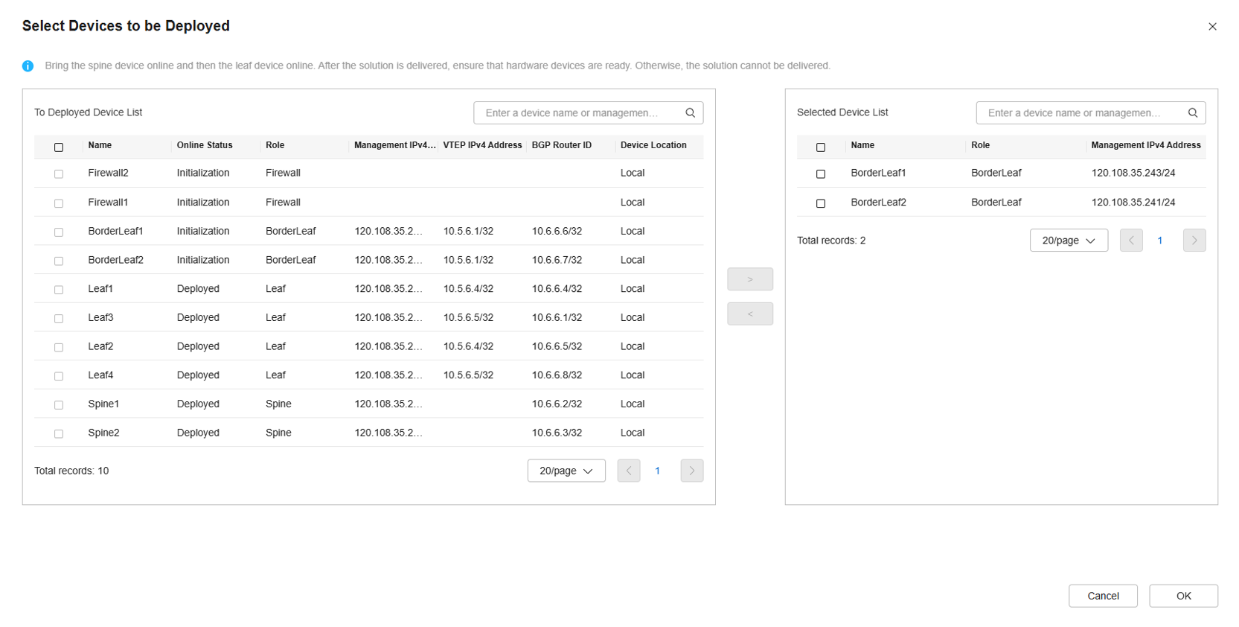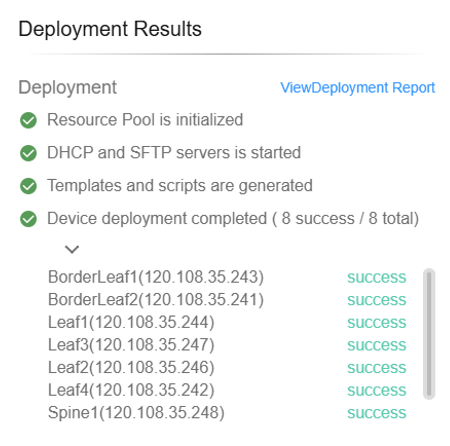1.3- Network Provisioning Execution
After confirming that the configuration scheme was free of mismatched settings and inconsistent parameters, we proceeded to deploy it to the physical network devices. All devices were installed and connected to the management network according to the topology. Additionally, each device was connected to a console server to allow log monitoring during the zero-touch provisioning process.
Before starting provisioning, we performed a factory reset on all devices using the console connection. This ensured a clean starting state.
The zero-touch provisioning process begins with the spine switches, which must be recognized by the NCE-Fabric using their Electronic Serial Numbers (ESNs). We entered the ESNs of both spine switches into the NCE-Fabric. Once registered, we selected the spine switches for onboarding and restarted them.
During the boot process, the spine switches automatically started zero-touch provisioning. They first requested an IP address from the DHCP server integrated into the NCE-Fabric. Along with the IP address, the DHCP server provided the location of a Python script used for onboarding. The spine switches downloaded this script via Secure File Transfer Protocol (SFTP) and executed it. The script connected the devices to the NCE-Fabric using predefined credentials and retrieved their configuration files.
Onboarding devices in the NCE-Fabric is a straightforward process. As shown in Figure 9, the user selects the required devices from the left panel, moves them to the right panel, and confirms the deployment.

Figure 9: Device Selection for Onboarding
After successfully onboarding the spine switches, we continued with the leaf and border leaf switches. These devices follow the same provisioning steps as the spines, but with a key difference: only the spines require ESNs to be manually entered. Leaf and border leaf switches are identified automatically by the NCE-Fabric based on their physical connection to the spine nodes. LLDP is used to verify each device's identity and position during this process. For example, a device connected to spine interface 1 is recognized as leaf 1, and the corresponding configuration is assigned accordingly.
We onboarded the leaf switches first, followed by the border leaf switches. Although these two steps cannot be performed simultaneously, their order is flexible—either group can be onboarded first. The only strict requirement is that all spine switches be onboarded before any other devices.
After completing the onboarding process, the NCE-Fabric displayed a deployment summary confirming the successful provisioning of all eight nodes, as shown in Figure 10.

Figure 10: Deployment Results Summary
We ran multiple connectivity checks using ICMP between the devices' loopback addresses to verify that the devices and the underly network were deployed correctly. All checks were successful, confirming that the onboarding process completed as expected.
ETSI GR ENI 049 states that Level 4 configuration and provisioning capabilities require "automatic device configuration with zero-touch deployment, and plug-and-play." In our testing, the NCE-Fabric met this requirement by successfully executing zero-touch onboarding and automatically applying device-specific configurations without manual intervention.
| < Previous | Next > |
